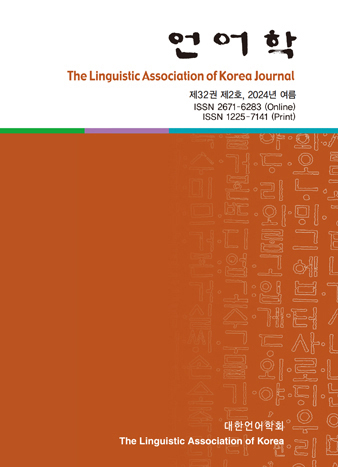대한언어학회 전자저널
32권 2호 (2024년 6월)
- 비전공 영어 문법 학습자의 미래 자아와 학습 참여가 의사소통 의지와 노력에 미치는 영향에 관한 예비 연구
-
김정아
Pages : 23-47
Abstract
Kim, Jeonga. (2024). A pilot study of the influence of English grammar learners future-self-guides and engagement on their willingness to communicate and intended efforts. The Linguistic Association of Korea Journal, 32(2), 23-47. This pilot study explores how different future self-guides (ideal L2 self and ought-to L2 selves) and engagement types (social, cognitive, and affective) influence EFL learners' willingness to communicate in English (L2 WTC) and intended learning efforts in an English grammar course. Multiple regression analysis examined the effects on WTC in two spatial settings (small group and classroom) and efforts across present and future. The findings revealed that the ideal L2 self increases WTC in the classroom setting but has no impacts on future efforts. In contrast, the ought-to L2 self: own influences future efforts. Interestingly, learners' sense of obligation, particularly built on parents' expectations (Ought-to L2 self: parents) had an impact on sustaining efforts (present and future) and WTC in a classroom setting. Engagement with enjoyment (not-bad type) and cognitive engagement emerged as key factors for stable effort across time. However, fun-and-interesting type engagement and social engagement positively impact WTC across settings and future efforts. These findings shed light on how educators can consider the influence of learners' L2 selves and engagement styles in shaping L2 WTC and efforts for different spatial and temporal contexts.
Keywords
# L2 학습자 미래 자아(Future-self-guides) # 이상적 L2 자아(Ideal L2 self) # 당위적 L2 자아(Ought-to L2 self) # 의사소통의지(Willingness to communicate) # 의도된 노력(Intended effort) # 학습 참여(Engagement)
References
- 박원우, 손승연, 박해신, 박혜상. (2010). 적정 표본크기 (sample size) 결정을 위한 제언. 노사관계연구, 21, 51-85.
- 차재형. (2023). R과 함께하는 의학통계: 통계적 방법 120. 파주: 자유아카데미.
- 황성동. (2019). 누구나 할 수 있는 jamovi 통계분석: 빈도분석에서 다층모형, R 구조방정식까지. 서울: 학지사.
- Bal, S. (2021). Analyzing the correlation between Ideal L2 self and Willingness to communicate in L2 among EFL learners. International Journal of Education, 10(1), 58-67.
- Dörnyei, Z. (2009). The L2 motivational self system. In Dörnyei, Z. & E. Ushioda (Eds.) Motivation, Language Identity and the L2 Self (pp.9-42). Cevedon, UK: Multilingual Matters.
- Finn, J. D., & Zimmer, K. S. (2012). Student enagement: What is it? Why does it matter? In Christenson, S. L., Reschly, A. L., & Wylie, C. (Eds.). Handbook of Research on Student Engagement (pp.91-131). Springer.
- Fredricks, J. A., Blumenfeld, P., & Paris, A. (2004). School engagement: Potential of concept: State of evidence. Review of Educational Research, 74, 59-119.
- Gardner, R. C. (1985). Social Psychology and Second Language Learning: The Role of Attitudes and Motivation. London: Edward Arnold.
- Ghorbani, M., & Rashvand, S. (2020). The impact of the Big Five personality traits and Motivational Self-System on Iranian EFL learners’ intended effort: An investigation into McAdams’ model of personality. RELC Journal, 53(6), 1-16.
- Helme, S., & Clarke, D. (2001). Identifying cognitive engagement in the mathematics classroom. Mathematics Education Research Journal, 13, 133-153.
- Higgins, E. T. (1998). Promotion and prevention: Regulatory focus as a motivational principle. Advances in Experimental Social Psychology 71(6), 1062-1083.
- Hiver, p., Al-Hoorie, A. H., & Mercer, S. (2020). Student Engagement in the Language Classroom. Multilingual Matters.
- Jang, Y., & Lee, J. (2019). The effects of ideal and ought-to L2 selves on Korean EFL learners’ writing strategy use and writing quality. Reading and Writing, 32(5), 1129-1148.
- Khajavy, G. H., Ghonsooly, B., Hosseini, A., & Choi, C. W. (2016). Willingness to communicate in English: A microsystem model in the Iranian EFL Classroom Context, TESOL Quarterly, 50, 154-180.
- Khajavy, G. H., MacIntyre, P. D., & Bardabadi, E. (2018). Role of the emotions and classroom environment in Willingness to Communicate. Studies in Second Language Acquisition, 40, 605-624.
- Kolsut, S., & Szumilas, M. (2023). Exploring student engagement in task- based and communicative language classrooms. Language Teaching Research, 1-30.
- Koné, K. (2023). Reading circles: Triggers for increased engagement of EFL learners in extensive reading. The Electric Journal of Teaching English as a Second or Foreign Language, 27(3), 1-21.
- Lee, S. J., & Lee, K. (2019). Role of L2 Motivational Self System on willingness to communicate of Korean EFL university and secondary students. Journal of Psycholinguistic Research, 49, 147-161.
- Liu, G., Fathi, J., & Rahimi, M. (2024). Using digital gamification to improve language achievement, foreign language enjoyment, and ideal L2 sefl: A case of English as a foreign language learners. Journal of Computer Assisted Learning 10(1), 58-67.
- MacIntyre, P. D., Dörnyei, Z., Clement, R., & Noels, A. (1998). Conceptualizing Willingness to Communicated in a L2: A situational model of L2 confidence and affiliation. The Modern Language Journal, 82(4), 545-562.
- Peng, J. E., & Woodrow, L. (2010). Willingness to communicate in English: A model in the Chinese EFL classroom context. Language Learning, 60(4), 834-876.
- Skinner, E. A., & Pitzer, J.R. (2012). Developmental dynamics of student engagement, coping, and everyday resilience. In S. L. Christenson, A. L. Reschly, & C. Wylie (Eds.), Handbook of research on student engagement (pp.21-44). New York: Guilford Press.
- Sugawara, K., & Sato, M. (2017). Future Self-Guides, Engagement-Specific Learning Experiences, and Emotional States Support Motivated Behavior in Japanese Learners of English. Annual Review of English Language Education in Japan, 31, 17-32.
- Svalberg, A. (2009). Engagement with language: Interrogating a construct. Language Awareness, 18, 242-258.
- Taguchi, T. Magid, M., & Papi, M. (2009). The L2 Motivational Self System among Japanese, Chinese and Iranian Learners of English: A comparative study. In Z. Dörnyei & E Shioda (Eds.), Motivation, Language Identity and the L2 Self (pp.66-97). Bristol: Multilingual Matters.
- Teimouri, Y. (2017). L2 Selves, Emotions, and Motivated Behaviors. Studies in Second Language Acquisition, 39(4), 681-709.
